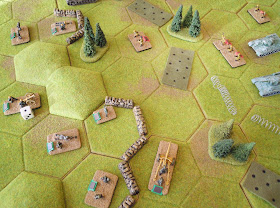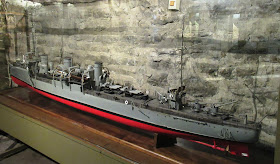In reply to a comment on my recent blog entry, Archduke Piccolo made mention of the Euclidean, Chebyshev, and Manhattan methods of measuring distances on a squared grid.
I knew a little (not much at all, in fact!) about the three different methods, but spurred on by his comment, I found out more ... and decided that what I found out might be of interest to other wargamers who use square gridded tabletops.
Euclidean Distance
Euclidean distance (or Euclidean metric) is the 'ordinary' straight-line distance between the centres of two grid squares as one would measure using a simple ruler.
It is named after Euclid of Alexandria, the Greek mathematician who is regarded as being the father of geometry.
Chebyshev Distance
Chebyshev distance (or maximum value distance) is a metric defined on a vector space where the distance between two vectors is the greatest of their differences along any coordinate dimension. For example, in Chebyshev distance all eight adjacent grid squares from a given grid square can be reached by one unit.
It is named after Pafnuty Lvovich Chebyshev, a Russian mathematician.
Manhattan Distance
Manhattan (or Taxicab) distance is the distance between two grid squares in a square grid using a strictly horizontal and/or vertical path as opposed to the diagonal or 'as the crow flies' one. The Manhattan distance is the simple sum of the number of horizontal and vertical grid squares used.
It takes its names from the shortest distance a taxicab can take to go from one place to another in a city built on a squared gridded pattern, such as Manhattan.
Note: According to Wikipedia:
I knew a little (not much at all, in fact!) about the three different methods, but spurred on by his comment, I found out more ... and decided that what I found out might be of interest to other wargamers who use square gridded tabletops.
Euclidean Distance
Euclidean distance (or Euclidean metric) is the 'ordinary' straight-line distance between the centres of two grid squares as one would measure using a simple ruler.
It is named after Euclid of Alexandria, the Greek mathematician who is regarded as being the father of geometry.
Chebyshev Distance
Chebyshev distance (or maximum value distance) is a metric defined on a vector space where the distance between two vectors is the greatest of their differences along any coordinate dimension. For example, in Chebyshev distance all eight adjacent grid squares from a given grid square can be reached by one unit.
It is named after Pafnuty Lvovich Chebyshev, a Russian mathematician.
Manhattan Distance
Manhattan (or Taxicab) distance is the distance between two grid squares in a square grid using a strictly horizontal and/or vertical path as opposed to the diagonal or 'as the crow flies' one. The Manhattan distance is the simple sum of the number of horizontal and vertical grid squares used.
It takes its names from the shortest distance a taxicab can take to go from one place to another in a city built on a squared gridded pattern, such as Manhattan.
Note: According to Wikipedia:
In mathematics, a metric or distance function is a function that defines a distance between each pair of elements of a set. A set with a metric is called a metric space.Well I hope that cleared that up for you!













































